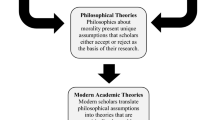Abstract
Recent events have raised concerns about the ethical standards of public and private organisations, with some attention falling on business schools as providers of education and training to managers and senior␣executives. This paper investigates the nature of, motivation and commitment to, ethics tuition provided by the business schools. Using content analysis of their institutional and home websites, we appraise their corporate identity, level of engagement in socially responsible programmes, degree of social inclusion, and the relationship to their ethics teaching. Based on published research, a schema is developed with corporate identity forming an integral part, to represent the macro-environment, parent institution, the business school and their relationships to ethics education provision. This is validated by our findings.
Similar content being viewed by others
Abbreviations
- AACSB:
-
Association to Advance Collegiate Schools of Business International
- CI:
-
Corporate Identity
- CSR:
-
Corporate Social Responsibility
- EETF:
-
Ethics Education Task Force
- MBA:
-
Master of Business Administration
- EMBA:
-
Executive Master of Business Administration
References
Albert S., Adams E. (2002) The hybrid identity of law firms. In: Moingeon B., Soenen G. (eds) Corporate and organizational identities: integrating strategy, marketing, communication and organizational perspectives. Routledge, London
Albert, S. and D. Whetton: 1985, 'Organizational Identity', in L. L. Cummings and B. M. Staw (eds.), Research in Organizational Behaviour Vol. 7 (JAI Press, Greenwich), pp. 263-269
Baker M. J., Balmer J. M. T. (1997) Visual identity: trappings of substance. European Journal of Marketing 31(5/6):366–82
Balmer J. M. T. (2001) Corporate identity, corporate branding and corporate marketing. European Journal of Marketing 35(3/4):248–291
Balmer J. M. T., Gray, E.R.: (2001), “Ethical Identity: What is it? What of IT?”, in C. L. Pass (ed.), University of Bradford School of Management Working Paper Series No.01/15
Balmer J. M. T., Soenen G. B. (1999) The Acid Test of Corporate Identity Management. Journal of Marketing Management 15(1):69–92
Balmer J. M. T., Wilson A. (1998) Corporate Identity: There is more to it than meets the eye. International Studies of Management & Organization 28(3):12–31
Boo E. H. Y., Koh H. C. (2001) The influence of organizational and code-supporting variables on the effectiveness of a code of ethics. Teaching Business Ethics 5(4):357–373
Cadbury A. (1992) Report of the Committee on the Financial Aspects of Corporate Governance. Gee Publishing, London
Christiensen L. T., Askergsaard S. (2001) Corporate identity and corporate image revisited. European Journal of Marketing 31(5/6):292–316
Cordiero W. P. (2003) The only solution to the decline in business ethics: ethical managers. Teaching Business Ethics 7(3):265–277
Cowton C., Cummins J. (2003) Teaching business ethics in UK higher education: progress and prospects. Teaching Business Ethics 7(1):37–54
Donaldson, T. and T. W. Dunfee: 1999, ‹Ties That Bind: A Social Contract Approach to Business Ethics', (Harvard Business School Press, Cambridge)
Donaldson, T. and L. E. Preston: 1995, `The Stakeholder Theory of the Corporation: Concepts, Evidence, and Implications', Academy of Management Review 20(1), 65-91
Dunfee T. W., Robertson D. C. (1988) Integrating ethics into the business school curriculum. Journal of Business Ethics 7(11):847–859
Financial Times: 2004, ‚Top 100 Full-time Global MBA Programmes’, http://www.specials.ft.com/spdocs/top100.pdf accessed November 2004
Friedman S. D. (1996) Community involvement projects in Wharton’s MBA curriculum. Journal of Business Ethics 15(1):95–101
Gioia D. A., Thomas J. B. (1996) Image identity and issue interpretation: Sensemaking during strategic change in academia. Administrative Science Quarterly 41:370–403
Gray E. R., Balmer J. M. T. (1998) Managing Corporate Image and Corporate Reputation. Long Range Planning 3(1):697–702
Hatch M. J., Schultz M. (1997) Relations between organizational culture, identity and leadership. European Journal of Marketing 31 (5/6):356–365
Karake Z. A. (1998) An examination of the impact of organisational downsizing and discrimination activities on corporate social reputation as measured by a company’s reputation index. Management Decision 36(3):206–216
Kelly, M.: 2005, “It’s a Hekuva Time to be Dropping Business Ethics Courses”, Business Ethics Online http://www.business-ethics.com/what’s_new/bestbizschools.html accessed March 2005
Labianca G., Fairbank J. F., Thomas J. B., Gioia D. A., Umphress J. B. (2001) Emulation in academia: balancing structure and identity. Organization Science 12(3):312–330
Melewar T. C., Akel S. (2005) The role of corporate identity in the higher education sector. Corporate Communications: An International Journal 10(1):41–57
Melewar T. C., Jenkins E. (2002) Defining the corporate identity construct. Corporate Reputation 5(1):76–91
Moir L. (2001) What do we mean by corporate social responsibility? Corporate Governance 1(2):16–22
Pfeffer J., Fong C. T. (2004) The business school ‚business’: some lessons from the US Experience. Journal of Management Studies 41(8):1501–1520
Phillips, S. M. (Chair): 2004, “Ethics Education In Business Schools”: Report of the Ethics Education Task Force to AACSB International Board of Directors, St. Louis, Missouri
Roussouw G. J. (2002) Three approaches to teaching business ethics. Teaching Business Ethics 6(4):411–433
Sarbanes, P. S., P. Gramm, M. G. Oxley and J. J. LaFalce: 2002, Securities and Exchange Commission: Certification of Disclosure in Company’s Quarterly and Annual Reports, GAO-02-1100R
Scott W.G. (1988) Profit at any price: The moral failure of business schools. In: Schermerhorm J.R., Hunt J.G., Osborn R.N. (eds) Managing Organisational Behaviour. New York, Wiley
Sims S. R., Sims S. J. (1991) Increasing applied business ethics courses in business school curricula. Journal of Business Ethics 10(3):211–219
Soenen G., Moingeon B. (2002) The five facets of collective identities: integrating corporate and organizational identity. In: Moingeon B., Soenen G. (eds) Corporate and organizational identities: integrating strategy, marketing, communication and organizational perspectives. Routledge, London
Takala T., Pallab P. (2000) Individual, collective and social Responsibility of The firm” Business. Ethics A European Review 9(2):109–118
Trompenaars, F. and C. Hampden-Turner: 1997, `Riding the Waves of Culture: Understanding Business', (Nicholas Brealey, London)
Trompenaars, F. and C. Hampden-Turner: 1999, ‚Teaching Business Ethics in a Cross-Cultural Context’, in Proceedings of the European Business Ethics Network (EBEN) (Christ Church College, Oxford)
Wallace, J., R. Tassabehji and N. Cornelius: 2005, ‚A Statistical Analysis of Corporate Identity, Corporate Social Responsibility and Ethics Teaching in Business Schools’, in C. L. Pass (ed.), University of Bradford School of Management Working Paper Series No.05/38
Wilkinson, A. and J. M. T. Balmer: 1996, `Corporate and Generic Identities: Lessons from the Co-operative Bank', International Journal of Bank Marketing 14(4) 22–35
Wilson, I.: 2000, `The New Rules: Ethics, Social Responsibility and Strategy', Strategy and Leadership 28(3) 12–16
Zairi M. (2000) Social responsibility and the impact on society. TQM Magazine 12(3):172–178
Zairi M., Peters J. (2002) The impact of social responsibility on business performance. Management Auditing Journal 17(4):172–178
Author information
Authors and Affiliations
Corresponding author
Additional information
Dr. Nelarine Cornelius, Reader in Human Resource Management and Organisational Behaviour, Brunel Business School, Brunel University, is a Fellow of the Chartered Institute of Personnel and Development and a Fellow of the Royal Society of Arts. She is also a Chartered Psychologist and is Director of both the Centre for Research in Emotion Work and the Human Resource Management and Organisational Behaviour Research Group at Brunel University.
Dr. James Wallace, Lecturer in Quantitative Methods, School of Management, University of Bradford, is a Fellow of the Royal Statistical Society. He has considerable experience of statistical and mathematical modelling gained over several years in the UK utilities sector and in H.E. His current research interests include, applying statistical and mathematical modelling approaches to Technological, Operational and General Management problems.
Dr. Rana Tassabehji, Lecturer in Information Systems and E-business, School of Management, University of Bradford, is a member of the British Academy of Management and the UK Academy for Information Systems. She worked as an international business consultant and as a consultant in the UK IT sector and is currently an academic member of the eGISE eGovernment network. Her research interests include ethics and e-business, Internet security and e-government.
Rights and permissions
About this article
Cite this article
Cornelius, N., Wallace, J. & Tassabehji, R. An Analysis of Corporate Social Responsibility, Corporate Identity and Ethics Teaching in Business Schools. J Bus Ethics 76, 117–135 (2007). https://doi.org/10.1007/s10551-006-9271-6
Published:
Issue Date:
DOI: https://doi.org/10.1007/s10551-006-9271-6




